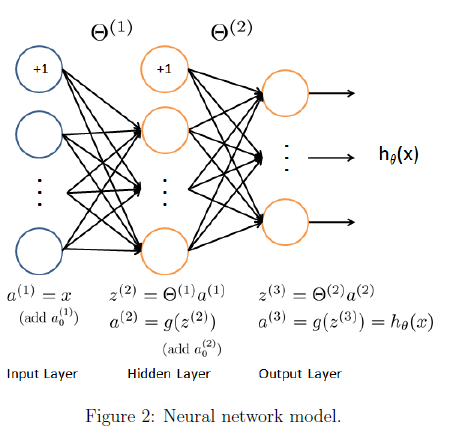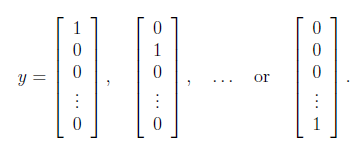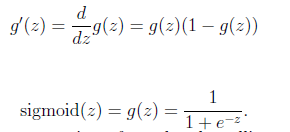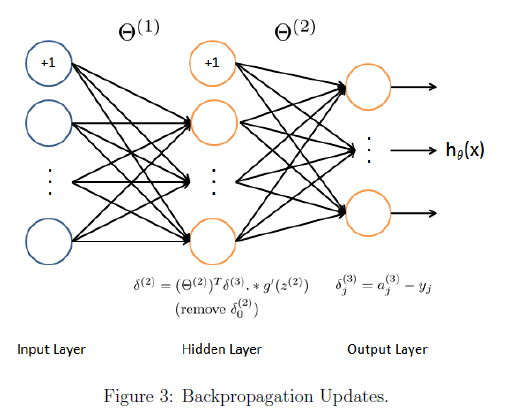Machine Learning week 5 programming exercise Neural Network Learning
阿新 • • 發佈:2019-02-02
Neural Networks Learning
Visualizing the data
這次試用的資料和上次是一樣的資料。5000個training example,每一個代表一個數字的影象,影象是20x20的灰度圖,400個畫素的每個位置的灰度值組成了一個training example。
Model representation
這裡我們使用如下的模型,共3層,其中第一層input有400個feature,另外還有bias unit。
這個練習中實現訓練了一些theta,通過如下的程式碼把theta1和theta2讀取出來
% Load saved matrices from file load('ex4weights.mat'); % The matrices Theta1 and Theta2 will now be in your workspace % Theta1 has size 25 x 401 % Theta2 has size 10 x 26
Feedforward and cost function
現在我們需要計算cost function和gradient 這裡是沒有regularization的情況下的cost function公式,m表示m個training example,k表示k個output,這裡我們有10個output,分別代表1-10
y的值需要從數字形式轉化為向量形式,如下,下面的例子中第一列表示1,第二列表示2

Regularized cost function
下面是regularized cost function,其實就是在普通的cost function後面加上每個theta的平方,當然不要忘了係數。不過這裡並不是所有的theta,所有跟bias unit相關的theta都要排除。
我們現在這裡寫的程式,指標對3層網路,但是對於由於每層unit數量不一樣出現的不同的網路,我們這裡也要相容
function [J grad] = nnCostFunction(nn_params, ... input_layer_size, ... hidden_layer_size, ... num_labels, ... X, y, lambda) %NNCOSTFUNCTION Implements the neural network cost function for a two layer %neural network which performs classification % [J grad] = NNCOSTFUNCTON(nn_params, hidden_layer_size, num_labels, ... % X, y, lambda) computes the cost and gradient of the neural network. The % parameters for the neural network are "unrolled" into the vector % nn_params and need to be converted back into the weight matrices. % % The returned parameter grad should be a "unrolled" vector of the % partial derivatives of the neural network. % % Reshape nn_params back into the parameters Theta1 and Theta2, the weight matrices % for our 2 layer neural network Theta1 = reshape(nn_params(1:hidden_layer_size * (input_layer_size + 1)), ... hidden_layer_size, (input_layer_size + 1)); Theta2 = reshape(nn_params((1 + (hidden_layer_size * (input_layer_size + 1))):end), ... num_labels, (hidden_layer_size + 1)); % Setup some useful variables m = size(X, 1); % You need to return the following variables correctly J = 0; Theta1_grad = zeros(size(Theta1)); Theta2_grad = zeros(size(Theta2)); % ====================== YOUR CODE HERE ====================== % Instructions: You should complete the code by working through the % following parts. % % Part 1: Feedforward the neural network and return the cost in the % variable J. After implementing Part 1, you can verify that your % cost function computation is correct by verifying the cost % computed in ex4.m % % Part 2: Implement the backpropagation algorithm to compute the gradients % Theta1_grad and Theta2_grad. You should return the partial derivatives of % the cost function with respect to Theta1 and Theta2 in Theta1_grad and % Theta2_grad, respectively. After implementing Part 2, you can check % that your implementation is correct by running checkNNGradients % % Note: The vector y passed into the function is a vector of labels % containing values from 1..K. You need to map this vector into a % binary vector of 1's and 0's to be used with the neural network % cost function. % % Hint: We recommend implementing backpropagation using a for-loop % over the training examples if you are implementing it for the % first time. % % Part 3: Implement regularization with the cost function and gradients. % % Hint: You can implement this around the code for % backpropagation. That is, you can compute the gradients for % the regularization separately and then add them to Theta1_grad % and Theta2_grad from Part 2. % #計算每層的結果,記得要把bias unit加上,第一次寫把a1 寫成了 [ones(m,1); X]; a1 = [ones(m,1) X]; z2 = Theta1 * a1'; a2 = sigmoid(z2); a2 = [ones(1,m); a2]; #這裡 a2 和 a1 的格式已經不一樣了,a1是行排列,a2是列排列 z3 = Theta2 * a2; a3 = sigmoid(z3); # 首先把原先label表示的y變成向量模式的output,下面用了迴圈 y_vect = zeros(num_labels, m); for i = 1:m, y_vect(y(i),i) = 1; end; #每一training example的cost function是使用的向量計算,然後for loop累加所有m個training example #的cost function for i=1:m, J += sum(-1*y_vect(:,i).*log(a3(:,i))-(1-y_vect(:,i)).*log(1-a3(:,i))); end; J = J/m; #增加regularization,一開始只寫了一個sum,但其實theta1 2 分別都是矩陣,一個sum只能按列累加,bias unit的theta不參與regularization J = J + lambda*(sum(sum(Theta1(:,2:end).^2))+sum(sum(Theta2(:,2:end).^2)))/2/m; #backward propagation #Δ的元素個數應該和對應的theta中的元素的個數相同 Delta1 = zeros(size(Theta1)); Delta2 = zeros(size(Theta2)); for i=1:m, delta3 = a3(:,i) - y_vect(:,i); #注意這裡的δ是不包含bias unit的delta的,畢竟bias unit永遠是1, #不需要計算delta, 下面的2:end,: 過濾掉了bias unit相關值 delta2 = (Theta2'*delta3)(2:end,:).*sigmoidGradient(z2(:,i)); #移除bias unit上的delta2,但是由於上面sigmoidGradient式子中 #的z,本身不包含bias unit,所以下面的過濾不必要,註釋掉。 #delta2 = delta2(2:end); Delta2 += delta3 * a2(:,i)'; #第一層的input是一行一行的,和後面的結構不一樣,後面是一列作為一個example Delta1 += delta2 * a1(i,:); end; #總結一下,δ不包含bias unit的偏差值,Δ對跟θ對應的,用來計算每個θ #後面的偏導數的,所以Δ包含bias unit的θ Theta2_grad = Delta2/m; Theta1_grad = Delta1/m; #regularization gradient Theta2_grad(:,2:end) = Theta2_grad(:,2:end) .+ lambda * Theta2(:,2:end) / m; Theta1_grad(:,2:end) = Theta1_grad(:,2:end) .+ lambda * Theta1(:,2:end) / m; % ------------------------------------------------------------- % ========================================================================= % Unroll gradients grad = [Theta1_grad(:) ; Theta2_grad(:)]; end
Backpropagation
Sigmoid gradient
sigmoid gradient反向傳播計算gradient的公式的一部分
function g = sigmoidGradient(z)
%SIGMOIDGRADIENT returns the gradient of the sigmoid function
%evaluated at z
% g = SIGMOIDGRADIENT(z) computes the gradient of the sigmoid function
% evaluated at z. This should work regardless if z is a matrix or a
% vector. In particular, if z is a vector or matrix, you should return
% the gradient for each element.
g = zeros(size(z));
% ====================== YOUR CODE HERE ======================
% Instructions: Compute the gradient of the sigmoid function evaluated at
% each value of z (z can be a matrix, vector or scalar).
g = sigmoid(z).*(1-sigmoid(z));
% =============================================================
endRandom initialization
為了打破symmetry breaking,我們要在選取初始theta的時候,每次選擇某一層的theta,然後讓每個這一層的theta都隨機選取,範圍 [-ξ,ξ] 有如下經驗公式可用來選擇合適的theta範圍
確定了範圍之後,下面是隨機選擇的過程
% Randomly initialize the weights to small values
epsilon init = 0.12;
W = rand(L out, 1 + L in) * 2 * epsilon init − epsilon init;Backpropagation
在反向傳播過程中,我們要計算除了input layer之外的每層的小 delta,也就是δ。參考下圖,
計算過程分為下面5步,每個training example都迴圈進行1-4: 1 forward propagation計算每一層的函式z,和每一層的activation,不要忘記途中增加bias unit 2 計算第三層的δ,

3 計算第二層的δ,

4計算每一層的Δ,這裡要搞清楚,δ代表當前層的所有unit個數,如果是hidden layer的話,還包括了bias unit。Δ的最終結果是當前層的theta的偏導數,和當前層的theta維數一致,通過δ計算Δ的時候,由於後層的δ中的bias unit並不是有當前層的theta計算到的,反向計算theta的偏導數,Δ的時候則要把其中的bias unit去掉

5 上面m個training example都迴圈計算完成之後,計算最後的偏導數

實際上這裡的第一步,可以一次性使用矩陣操作計算完成所有m個訓練資料的結果,但是後面的幾步,還是要迴圈計算每個訓練資料的結果
Gradient checking
這裡主要是對我們上面編寫的計算偏導數的函式進行驗證的一個方法,通過比較上面計算結果和這裡計算的估計結果的關係來判斷,我們的code是否正確。
這裡我們選擇ε= 10^−4, 最終我們會看到我們計算的偏導數和估計的偏導數差值應該是 1e-9的數量級。
當然這裡計算的時候可以使用比較少的unit的網路,因為這裡估計值的計算計算量很大。
function numgrad = computeNumericalGradient(J, theta)
%COMPUTENUMERICALGRADIENT Computes the gradient using "finite differences"
%and gives us a numerical estimate of the gradient.
% numgrad = COMPUTENUMERICALGRADIENT(J, theta) computes the numerical
% gradient of the function J around theta. Calling y = J(theta) should
% return the function value at theta.
% Notes: The following code implements numerical gradient checking, and
% returns the numerical gradient.It sets numgrad(i) to (a numerical
% approximation of) the partial derivative of J with respect to the
% i-th input argument, evaluated at theta. (i.e., numgrad(i) should
% be the (approximately) the partial derivative of J with respect
% to theta(i).)
%
numgrad = zeros(size(theta));
perturb = zeros(size(theta));
e = 1e-4;
for p = 1:numel(theta)
% Set perturbation vector
perturb(p) = e;
loss1 = J(theta - perturb);
loss2 = J(theta + perturb);
% Compute Numerical Gradient
numgrad(p) = (loss2 - loss1) / (2*e);
perturb(p) = 0;
end
endRegularized Neural Networks


計算的時候,所有和bias項對應的theta都不需要做regularization
Learning parameters using fmincg
略Visualizing the hidden layer
這裡很有意思,我們的input是400個畫素點的灰度值,而theta1的每一行都是一個401的vector,去掉第一個,同樣得到一個400的vector,然後我們把它可視化出來,可以大概看到我們做了什麼
change lambda
不同的λ,會得到不同的結果,怎麼選取lambda呢?%% Machine Learning Online Class - Exercise 4 Neural Network Learning
% Instructions
% ------------
%
% This file contains code that helps you get started on the
% linear exercise. You will need to complete the following functions
% in this exericse:
%
% sigmoidGradient.m
% randInitializeWeights.m
% nnCostFunction.m
%
% For this exercise, you will not need to change any code in this file,
% or any other files other than those mentioned above.
%
%% Initialization
clear ; close all; clc
%% Setup the parameters you will use for this exercise
input_layer_size = 400; % 20x20 Input Images of Digits
hidden_layer_size = 25; % 25 hidden units
num_labels = 10; % 10 labels, from 1 to 10
% (note that we have mapped "0" to label 10)
%% =========== Part 1: Loading and Visualizing Data =============
% We start the exercise by first loading and visualizing the dataset.
% You will be working with a dataset that contains handwritten digits.
%
% Load Training Data
fprintf('Loading and Visualizing Data ...\n')
load('ex4data1.mat');
m = size(X, 1);
% Randomly select 100 data points to display
sel = randperm(size(X, 1));
sel = sel(1:100);
displayData(X(sel, :));
fprintf('Program paused. Press enter to continue.\n');
pause;
%% ================ Part 2: Loading Parameters ================
% In this part of the exercise, we load some pre-initialized
% neural network parameters.
fprintf('\nLoading Saved Neural Network Parameters ...\n')
% Load the weights into variables Theta1 and Theta2
load('ex4weights.mat');
% Unroll parameters
nn_params = [Theta1(:) ; Theta2(:)];
%% ================ Part 3: Compute Cost (Feedforward) ================
% To the neural network, you should first start by implementing the
% feedforward part of the neural network that returns the cost only. You
% should complete the code in nnCostFunction.m to return cost. After
% implementing the feedforward to compute the cost, you can verify that
% your implementation is correct by verifying that you get the same cost
% as us for the fixed debugging parameters.
%
% We suggest implementing the feedforward cost *without* regularization
% first so that it will be easier for you to debug. Later, in part 4, you
% will get to implement the regularized cost.
%
fprintf('\nFeedforward Using Neural Network ...\n')
% Weight regularization parameter (we set this to 0 here).
lambda = 0;
J = nnCostFunction(nn_params, input_layer_size, hidden_layer_size, ...
num_labels, X, y, lambda);
fprintf(['Cost at parameters (loaded from ex4weights): %f '...
'\n(this value should be about 0.287629)\n'], J);
fprintf('\nProgram paused. Press enter to continue.\n');
pause;
%% =============== Part 4: Implement Regularization ===============
% Once your cost function implementation is correct, you should now
% continue to implement the regularization with the cost.
%
fprintf('\nChecking Cost Function (w/ Regularization) ... \n')
% Weight regularization parameter (we set this to 1 here).
lambda = 1;
J = nnCostFunction(nn_params, input_layer_size, hidden_layer_size, ...
num_labels, X, y, lambda);
fprintf(['Cost at parameters (loaded from ex4weights): %f '...
'\n(this value should be about 0.383770)\n'], J);
fprintf('Program paused. Press enter to continue.\n');
pause;
%% ================ Part 5: Sigmoid Gradient ================
% Before you start implementing the neural network, you will first
% implement the gradient for the sigmoid function. You should complete the
% code in the sigmoidGradient.m file.
%
fprintf('\nEvaluating sigmoid gradient...\n')
g = sigmoidGradient([1 -0.5 0 0.5 1]);
fprintf('Sigmoid gradient evaluated at [1 -0.5 0 0.5 1]:\n ');
fprintf('%f ', g);
fprintf('\n\n');
fprintf('Program paused. Press enter to continue.\n');
pause;
%% ================ Part 6: Initializing Pameters ================
% In this part of the exercise, you will be starting to implment a two
% layer neural network that classifies digits. You will start by
% implementing a function to initialize the weights of the neural network
% (randInitializeWeights.m)
fprintf('\nInitializing Neural Network Parameters ...\n')
initial_Theta1 = randInitializeWeights(input_layer_size, hidden_layer_size);
initial_Theta2 = randInitializeWeights(hidden_layer_size, num_labels);
% Unroll parameters
initial_nn_params = [initial_Theta1(:) ; initial_Theta2(:)];
%% =============== Part 7: Implement Backpropagation ===============
% Once your cost matches up with ours, you should proceed to implement the
% backpropagation algorithm for the neural network. You should add to the
% code you've written in nnCostFunction.m to return the partial
% derivatives of the parameters.
%
fprintf('\nChecking Backpropagation... \n');
% Check gradients by running checkNNGradients
checkNNGradients;
fprintf('\nProgram paused. Press enter to continue.\n');
pause;
%% =============== Part 8: Implement Regularization ===============
% Once your backpropagation implementation is correct, you should now
% continue to implement the regularization with the cost and gradient.
%
fprintf('\nChecking Backpropagation (w/ Regularization) ... \n')
% Check gradients by running checkNNGradients
lambda = 3;
checkNNGradients(lambda);
% Also output the costFunction debugging values
debug_J = nnCostFunction(nn_params, input_layer_size, ...
hidden_layer_size, num_labels, X, y, lambda);
fprintf(['\n\nCost at (fixed) debugging parameters (w/ lambda = 10): %f ' ...
'\n(this value should be about 0.576051)\n\n'], debug_J);
fprintf('Program paused. Press enter to continue.\n');
pause;
%% =================== Part 8: Training NN ===================
% You have now implemented all the code necessary to train a neural
% network. To train your neural network, we will now use "fmincg", which
% is a function which works similarly to "fminunc". Recall that these
% advanced optimizers are able to train our cost functions efficiently as
% long as we provide them with the gradient computations.
%
fprintf('\nTraining Neural Network... \n')
% After you have completed the assignment, change the MaxIter to a larger
% value to see how more training helps.
options = optimset('MaxIter', 50);
% You should also try different values of lambda
lambda = 1;
% Create "short hand" for the cost function to be minimized
costFunction = @(p) nnCostFunction(p, ...
input_layer_size, ...
hidden_layer_size, ...
num_labels, X, y, lambda);
% Now, costFunction is a function that takes in only one argument (the
% neural network parameters)
[nn_params, cost] = fmincg(costFunction, initial_nn_params, options);
% Obtain Theta1 and Theta2 back from nn_params
Theta1 = reshape(nn_params(1:hidden_layer_size * (input_layer_size + 1)), ...
hidden_layer_size, (input_layer_size + 1));
Theta2 = reshape(nn_params((1 + (hidden_layer_size * (input_layer_size + 1))):end), ...
num_labels, (hidden_layer_size + 1));
fprintf('Program paused. Press enter to continue.\n');
pause;
%% ================= Part 9: Visualize Weights =================
% You can now "visualize" what the neural network is learning by
% displaying the hidden units to see what features they are capturing in
% the data.
fprintf('\nVisualizing Neural Network... \n')
displayData(Theta1(:, 2:end));
fprintf('\nProgram paused. Press enter to continue.\n');
pause;
%% ================= Part 10: Implement Predict =================
% After training the neural network, we would like to use it to predict
% the labels. You will now implement the "predict" function to use the
% neural network to predict the labels of the training set. This lets
% you compute the training set accuracy.
pred = predict(Theta1, Theta2, X);
fprintf('\nTraining Set Accuracy: %f\n', mean(double(pred == y)) * 100);
